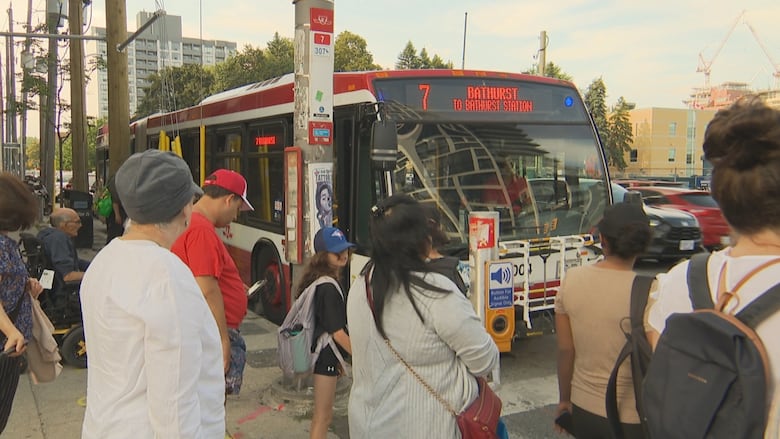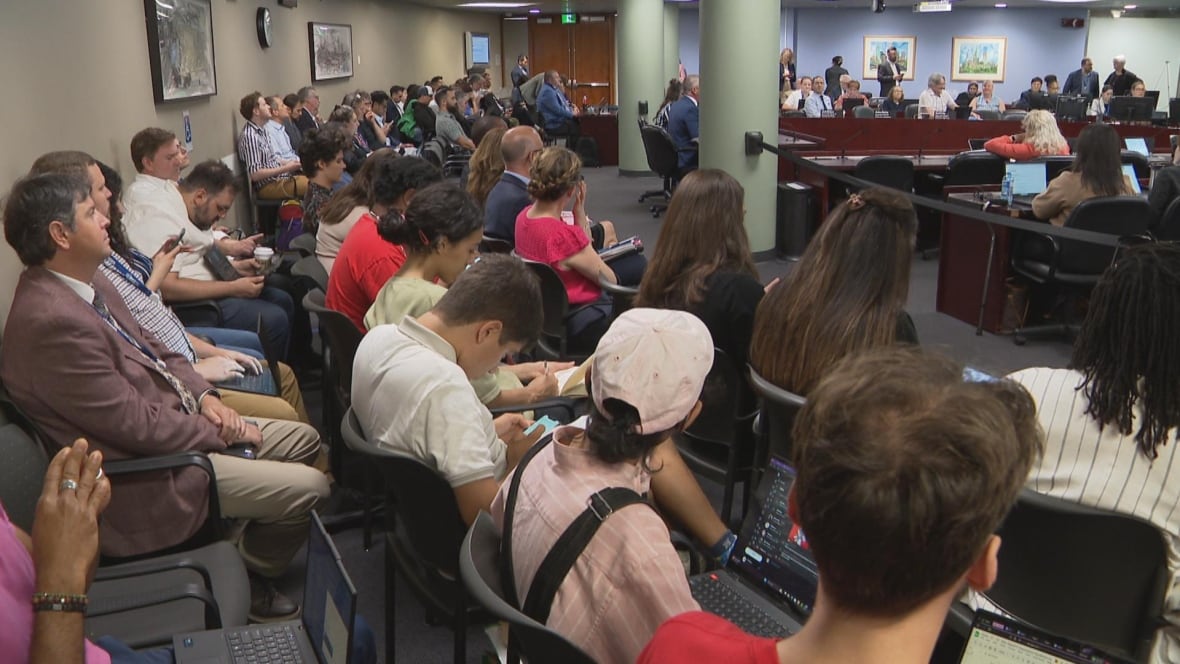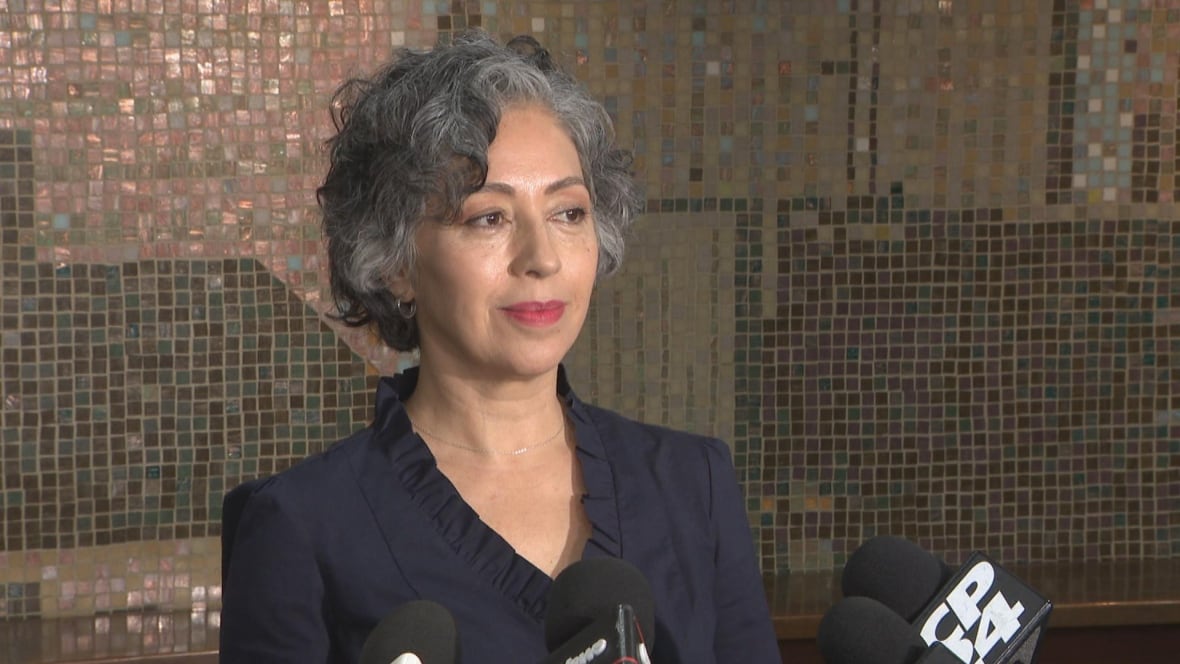Toronto council approves priority transit lanes on Bathurst and Dufferin streets
Lanes will run south of Bloor Street W., councillors decided Wednesday

Toronto city council has decided to proceed with priority transit lanes on Bathurst and Dufferin streets, south of Bloor Street W., to ease traffic congestion.
The decision comes before Toronto hosts six FIFA World Cup games in 2026. The Surface Transit Network Plan, called RapidTO, is a city initiative with the TTC that aims to enhance bus and streetcar transit across Toronto.
In separate votes at its Wednesday meeting, council voted 18 to 5 for RapidTO lanes on Bathurst Street and voted 20 to 3 for RapidTO lanes on Dufferin Street.
Bathurst will get a streetcar-only lane from Bloor Street W. to Lake Shore Boulevard W., except for a stretch between Nassau Street and Dundas Street W. due to Toronto Western Hospital construction, while Dufferin will get a bus-only lane from Bloor Street W. to King Street W.
Mayor Olivia Chow addressed the controversial issue before the vote, saying there were "legitimate concerns" expressed at council's recent executive committee meeting, where about 90 people argued for and against the lanes.
'Change is always hard': mayor
But Chow said the lanes are needed to keep people moving on Bathurst and Dufferin, and according to the TTC, the lanes will lead to thousands more people taking the TTC.
"Change is always hard, but once it's put in, people love those dedicated streetcar lanes," Chow told reporters at city hall.
"All the major metropolises around the world have dedicated bus lanes and they run very smoothly. It's just putting them in requires a lot of negotiations, a lot of working with the local businesses and residents as to where they would load and where they would park. But we absolutely need to have dedicated bus lanes."

Originally, the priority transit lanes on both roads were supposed to stretch to Eglinton Avenue W. but opposition from local resident associations and business owners, worried about the prospect of losing curbside parking, prompted staff to revise the plan.
A report presented to council said the priority bus lanes on Dufferin would be in red: "The installation of priority bus lanes would be carried out through changes to signage, red Methyl Methacrylate (MMA) coloured lane treatment, pavement markings, and traffic signals."
Not all councillors support the priority transit lanes, however.
Councillors divided on plan
Coun. Stephen Holyday, who represents Etobicoke Centre, said council will close down two lanes on two busy streets and that there are many questions about the usefulness of that plan.
"It's using FIFA as an excuse to have more war on the car," Holyday told reporters.
"That's going to have a profound impact to local businesses, to residents and people that are accessing the downtown core. The trade-off is try to help transit move faster during rush hour. What about all the other hours of the day that the red lanes will stare at people, causing problems on that street?" he added.
"There's very little alternative for people that need to drive these downtown corridors."
Coun. Brad Bradford, who represents Beaches-East York, said the city should implement temporary transportation solutions during the World Cup — not permanent ones — and the work hasn't been done to develop a solution that will be feasible over time.
"I think this is being thrust on Torontonians under the guise of a response to the World Cup," Bradford said. "I don't think paint on the road is the kind of legacy that people were expecting from the World Cup. I think more traffic congestion is going to be a legacy of this and council is moving in the wrong direction."

Councillors who represents wards that will be affected by the lanes were more open to the plan.
Coun. Alejandra Bravo, who represents Davenport, which includes Dufferin Street, said changes to traffic patterns cannot be delayed and it's important that they happen now.
"There are some councillors that are against everything," Bravo said. "Just being against everything isn't going to solve congestion. It's just about performing here and being against what this vision is from this mayor and this council."
Coun. Dianne Saxe, who represents University-Rosedale, said installing priority transit lanes is the right thing to do.
"We have far more people than our streets were designed for and we have only two choices. We can have everybody sit in gridlock or we can get most trips happening without a personal vehicle. Those are our only two choices and we can't expect people to move onto transit if transit is stuck in traffic sitting behind a parked car."
The city has said crews will begin work on the priority transit lanes starting this fall. After the World Cup, city staff will review the lanes and look at the idea of extending them north to Eglinton Avenue W.
Advocacy groups applaud decision
Two advocacy groups, TTCriders and Toronto Environmental Alliance (TEA), applauded the decision in a news release on Wednesday.
Andrew Pulsifer, executive director of TTCriders, said the move is a step forward.
"Implementing these lanes will make transit more reliable and encourage more people to take a bus or streetcar instead of driving," Pulsifer said in the release.
Emmay Mah, Executive Director of TEA, said the move means the city is prioritizing the use of public transit.
"We are very encouraged that Council has supported this initial phase of work, which will help move more residents rapidly along the Dufferin and Bathurst corridors, while making important progress towards Toronto's climate goals," Mah said.